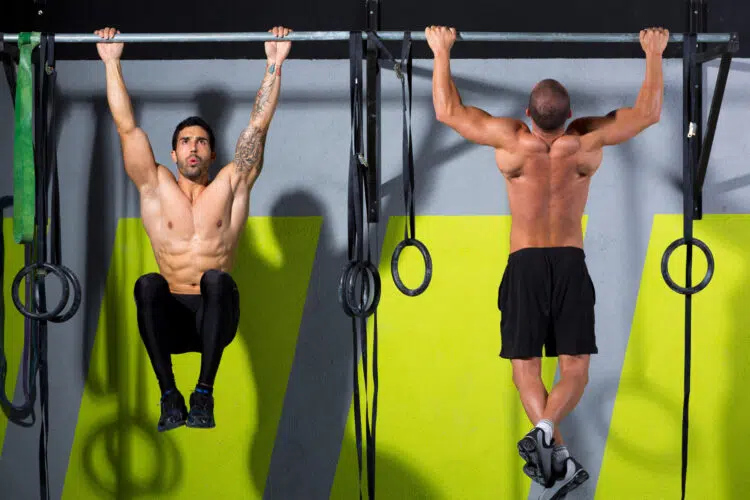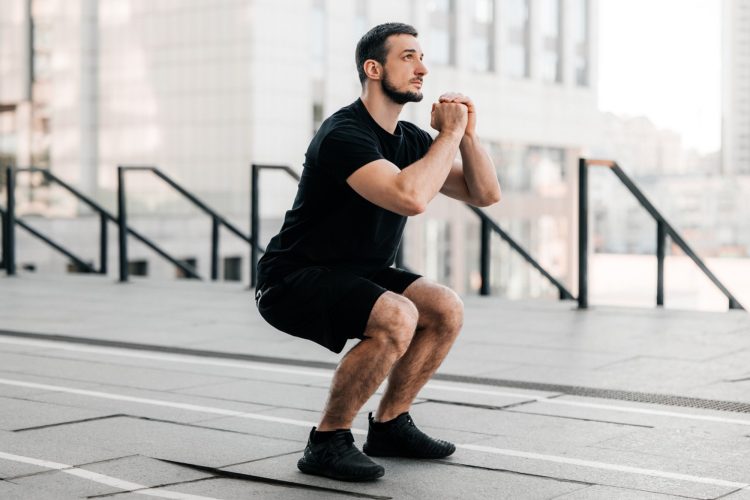I am incredibly fit and athletic — or so I thought.
As someone who has been working out for almost two decades, I am always on the lookout for challenging workouts. Although I’ve known about CrossFit ‘Girl’ workouts for a long time, it wasn’t until recently that I decided to give it a go.
Which workout did I choose, you ask?
Chelsea — and I borderline regret it.
Chelsea is the mother of all high-intensity interval training (HIIT) workouts. When someone tells me they have not tried the Chelsea workout, I am confused about whether I should congratulate them or recommend that they try it as soon as possible.
In this article, I take you over my experience of trying the Chelsea workout for the first time. I’ll include the physical and mental hurdles that I encountered so that you are prepared for when you decide to try this workout for yourself.
Level Up Your Fitness: Join our 💪 strong community in Fitness Volt Newsletter. Get daily inspiration, expert-backed workouts, nutrition tips, the latest in strength sports, and the support you need to reach your goals. Subscribe for free!
Introduction To Chelsea
Chelsea is a CrossFit ‘Girl’ benchmark workout. Don’t let the name fool you. This WOD is not just for the ladies; many ‘fit’ guys have a hard time completing this challenge.
CrossFit Girl workouts are used to assess a person’s CrossFit skills. You must track your performance in every CrossFit benchmark workout to analyze your progress. They also allow you to compare your performance with other CrossFitters for a healthy challenge.
Trivia: CrossFit founder Greg Glassman liked how the National Weather Service names storms after women. He reckoned that naming these workouts after women is fitting because they hit you like a storm.
“I thought that anything that left you flat on your back, looking up at the sky asking ‘what just happened to me?’ deserved a female name.” — Greg Glassman
Chelsea Workout
EMOM for 30 minutes:
For the uninitiated, an “EMOM” (every minute on the minute) workout is a type of interval training that involves completing a set number of repetitions of an exercise within a minute, followed by a rest period for the remaining time.
In the context of ‘Chelsea,’ this involves performing five pull-ups, 10 push-ups, and 15 air squats within a single minute. If there is any time left after completing the 30 total reps, you can use it for rest before starting the next round.
The first goal of this WOD is to complete all 30 reps in every minute.
Your total score is the number of rounds completed in 30 minutes, with 30 rounds being the best possible score. If you can complete the entire thing, you’ll have done 150 pull-ups, 300 push-ups, and 450 air squats in 30 minutes. That is a big achievement. Don’t let anyone tell you otherwise.
Even if you complete 29 reps in a round, that won’t count toward your total score.
Here is a pro tip for you: perform this workout near a pull-up bar so you don’t waste time walking around the gym.
Coach Tip: This workout is best suited for intermediate and advanced athletes, who should be able to finish all 30 rounds as prescribed.
Phase One: The First 10 Minutes
Although I had previously dabbled in CrossFit workouts, I’m more of a traditional gym rat. I took all the necessary precautions and steps to ensure I was ready for this challenge.
Since this is a 30-minute high-intensity workout, I warmed up by performing dynamic stretches and a few reps of each exercise for 10 minutes. This ensured my muscles, joints, tendons, and ligaments were primed for the EMOM workout.
My plan for this workout was pretty straightforward — go full-send in each round so I have a ton of time to rest before starting again.
Honestly, the first round of this WOD felt easy — in fact, it was too easy, which made me wonder if I was doing things right. I had heard that this was an incredibly brutal challenge, but even until the fifth round, I was cruising through the EMOMs.
And just when I was beginning to feel like I should start competing in CrossFit comps, my lats, chest, triceps, quads, and glutes started to burn. The cyclical nature of Chelsea was taking its toll on my muscles.
I was initially aiming for a 15 to 20-second rest between the rounds. By the end of phase one, the rest started feeling like a brief pause, just enough so I could regroup and get in position for the squats.
Phase Two: Minutes 10-20
Five, 10, and 15 reps — sounds pretty simple, right? However, I started to lose the sense of reps and exercise order as soon as the second phase began.
The initial ease with which I was performing these EMOMs had vanished, and I could hear my heartbeat in my ears.
My brain went into overdrive, and for the first time in a very long time, I realized that 30 minutes is a very long time.
At this point, I realized the ‘Girl’ CrossFit WOD workouts are meant to be both mentally and physically exhausting. You must push past the burn to complete each round. There’ll be times when you’ll want to stop, but you must persist. This is where the mental toughness truly takes over.
That said, you must ensure proper form throughout the workout to minimize the possibility of injury, especially when fatigue starts to set in.
Level Up Your Fitness: Join our 💪 strong community in Fitness Volt Newsletter. Get daily inspiration, expert-backed workouts, nutrition tips, the latest in strength sports, and the support you need to reach your goals. Subscribe for free!
While I could still complete all the 10 rounds in this phase with time to spare, the margin was steadily sinking, and I was down to around 10 seconds per round, maybe even five in some rounds.
Around this time, I also realized that the final 10 minutes would be very intense since all my major muscle groups were gorging with blood and lactic acid.
Hydration is critical during this workout, especially for people like me who sweat a lot. I tried this challenge during the summer heat and was soaked within the first 10 minutes. I used the rest time during the second and third phases (10 to 30th minutes) to sip on water and wipe the sweat off my face.
Phase Three: The Final 10 Minutes
Breaking the workout down into smaller chunks was the only way to get through this challenge. I was no longer aiming for 30 unbroken reps. I did five push-ups and rested for a few seconds before completing the remaining reps. Same for the air squats.
My rest time between sets? None. Nada. Zero.
The brief breather intraset was all I had. My form really started to break down during the last five minutes. No matter how hard I tried, I couldn’t fix it.
The gym started to fade during the final three minutes of this workout, and my world had narrowed down to the pull-up bar and the floor. Although this might sound poetic, my muscles burned like it was the end of the world.
I had to constantly dig deep to push harder during this final phase and not give in to the doubts and the urge to quit.
Nonetheless, I experienced an adrenaline rush in the final minute and gave the final round all I had (which wasn’t a lot). The final rep of air squat before the buzzer sound was one of the biggest reliefs (and satisfaction) I had experienced in a long time.
I couldn’t believe that I had completed 30 rounds of this challenge. A perfect score had felt like a distant dream during the second phase.
I won’t lie; my hands and legs trembled after I had completed the workout, and it took them a full 10-odd minutes to go back to normal.
Takeaways After Completing the Chelsea WOD
You are literally racing the clock in this workout. You will slow down, but the clock won’t.
I had sweat in my eyes, and if you have never experienced this before — it stings like crazy!
I won’t lie: I felt like throwing up for a long time after completing this challenge.
In hindsight, the biggest mistake I made was that I did not pace myself. Instead of going pedal to the metal from the first minute, I should have gone easy and tried to save as much energy as possible during the first half of this workout.
This workout is all about balance, and you want to avoid exhausting yourself.
Instead of going full-send, aim to have the same amount of rest each subsequent round. For example, aim to get 10 to 20 seconds of rest in each round for the entire workout.
I highly recommend using a wall stopwatch that is big enough that you can look at it throughout the workout. Wristwatches are great, but they can become inconvenient.
Let me tell you this: no matter how fit you are. You’ll barely complete the 30 reps in the one-minute cap during the latter half of the workout.
So, what do you do when you can’t perform the recommended number of reps every minute?
You keep going and perform as many as possible (AMRAP) within each minute. Another way to look at this is this benchmark workout has a built-in scale if you fail to meet the interval.
Pull-ups were undoubtedly the most challenging exercise for me during this workout after my grip strength started fatiguing. Holding onto the bar for even five reps during the final 10 minutes was a challenge in itself. It was the first time I got a forearm pump during push-ups.
Can You Survive 30 Minutes of Chelsea?
Remember, you don’t want to bite off more than you can chew during this challenge. Beginners should scale the Chelsea workout to allow their body time to adapt to the new training demands.
There are three main ways you could do this:
- Lower the number of reps per circuit.
- Increase the rest intervals between rounds.
- Reduce the total number of rounds.
Increase the number of sets and reps as you gain more experience. Avoid making all the training volume changes at once. Begin with one variable and add to it as you get more comfortable.
Conversely, if you finished the Chelsea workout as prescribed, add more volume. For example, add one rep to each exercise and see if you can do the full 30 rounds.
Coach Tip: Pull-ups and push-ups are not always the most beginner-friendly exercises. Although you can switch these exercises in this WOD, I would rather recommend choosing a different ‘Girl’ WOD with suitable exercises. This ensures you’re retaining the overall integrity of the training session.
Finally, you must learn to listen to your body. Discontinue the workout if something feels weird or unnatural. Feel free to scale the workout depending on your experience level. Like with everything else in the fitness world, staying consistent and disciplined will take you toward your fitness goals.
Conclusion
The Chelsea WOD was one of the most intense challenges I’ve tried in a very long time, and I would highly recommend intermediate and advanced lifters give it a shot. Beginners, too, can try it with appropriate scaling.
This workout nearly broke me, but I’m really glad I did something that pushed me out of my comfort zone. Trying new things in the gym ensures your workouts are always exciting, and you never lose the motivation to train.
If you have any questions about the Chelsea workout, post them in the comments below, and I’ll be happy to help!












